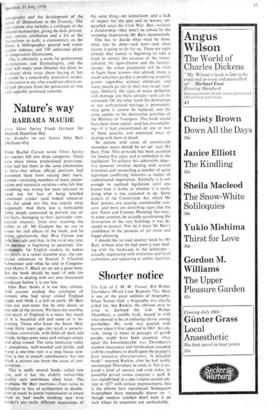Comedy turns
MICHAEL BORRIE
Illuminated Manuscripts of the Divine Comedy Peter Brieger, Millard Meiss and Charles S. Singleton (Rciutledge 2 vols £22)
These splendid volumes, planned for the seventh centenary of Dante's birth in 1965, are a particularly appropriate tribute to his genius. The first artist he met in Purgatory was Oderisi the illuminator, consigned there for the sin of pride: `Oh', I said, 'are you not Oderisi, the honour of Gubbio and the honour of the art that in Paris is called illumination?'
`Brother', he said, 'the pages Franco of Bologna paints smile more (pit) ridon-le carte): the honour is now all his—and mine in part.'
Clearly, Dante respected illumination as an art, in spite of the fact that in his time it was more highly deieloped north of the Alps than in Italy.
The editors' purpose is `to present the public with a comprehensive view of the illuminated codices of the Divine Comedy': a challenging task for few works achieved a more instantaneous popularity in the Middle Ales, or multiplied their copies more rapidly. At least six hundred manuscripts of the Comedy (not of course all illuminated) survive from the fourteenth century alone, including numerous commentaries and ex- planatory glosses on the text. Its subject matter was from the first recognised as ideal for illustration; primarily, one suspects, be- cause it gave almost unlimited scope for depicting the gruesome torments oft the daMned, whose contemplation was so dear to the mediaeval mind. The inferno was cer- tainly considerably more popular as a subject for illustration than the Purgatorio or the Paradiso (though Professor Meiss puts this down to the fact that the Inferno comes first, and that it was vastly expensive to do it all).
The earliest illuminated manuscripts of the Comedy were produced within ten or fifteen years of the poet's death in 1321. By the mid- fourteenth century. a regular canon of illu- strations to the work had developed. which remained in vogue to the end of the Middle Ages. The editors have selected fifty-three manuscripts for illustration, chosen both for their quality and their iconographic signifi- cance. The plates (there are more than 500) are arranged in the order of the episodes of the Comedy which they illustrate. allowing easy comparison.
The text consists of a series of essays. Charles S. Singleton writes on Dante's imagery, with particular reference to the problems of rendering it into graphic art. Millard Meiss discusses the artistic attribu- tions of the principal manuscripts. in a chapter which will provide plenty of material for some good. clean art-historical fun. He argues particularly for the attribution of one of the earliest illuminated codices. the Chan- tilly Ms. to a Pisan follower of Francesco Traini. and for the attribution of the Inferno and Purgatorio in the Yates Thompson MS to Priamo della Quercia rather than Lorenzo Vecchietta. Peter Brieger writes on the iconography and the development of the canon of illustrations to the Comedy. The text volume also includes a catalogue of the selected manuscripts, giving the date, proven- ance, artistic attribution and a list of the' illustrations in each; a commentary on the plates; a bibliography; general and icono- craphic indexes; and 130 additional plates of comparative illustrations.
This is obviously a work for professional art-historians and Danteologists, and the price will make most libraries (let alone in-
dis think twice about buying it; but it would be a remarkably insensitive reader, art historian or no, who would not obtain un- alloyed pleasure from the possession of two such superbly produced volumes.































 Previous page
Previous page